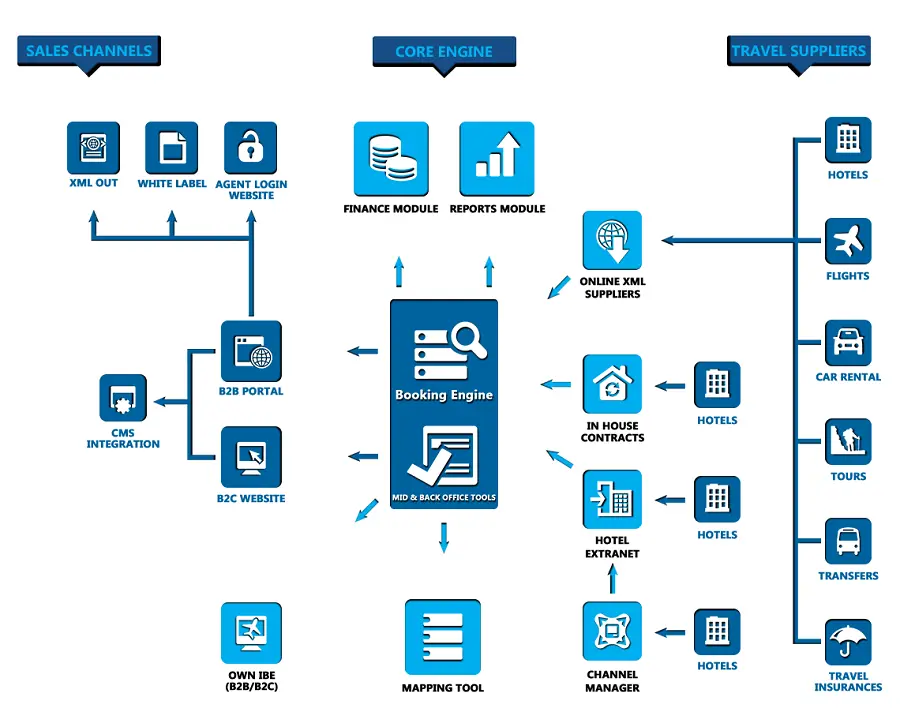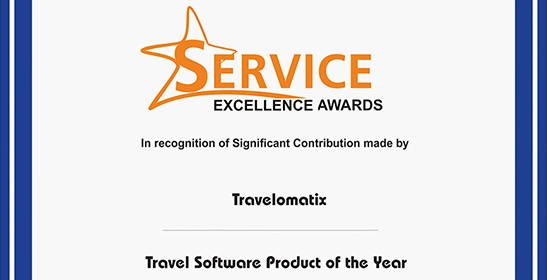Flight Reservation System - Booking Process, List of Features, Software Cost (2024)
24 Jun, 2024
Ryan
A flight reservation system is a technology platform that allows individuals and travel agencies to search for, book, and purchase airline tickets. These software solutions are essential to the aviation and travel industries, offering a user-friendly interface for ticket booking, modifications, and cancellations. Driven by the global increase in travel and the ongoing digital transformation of the travel sector, the demand for
flight reservation system
platforms remains strong. As more travelers seek convenient and efficient ways to plan their trips, flight booking software plays a crucial role in addressing these needs.
Travelomatix is a leading
travel portal development and
flight reservation software
provider. We offer a comprehensive array of travel tech solutions including software platforms equipped with mobile apps, covering diverse services such as airlines, hotels, transfers, cruise, rails, insurance and ancillary services. With a global presence, we serve airlines, travel agencies, DMCs in the United States, Canada, India, Europe, Middle East, Africa and other leading tourism destinations. Our dedicated team of over 275 professionals excels in travel ticketing technology and mobile apps development, ensuring expertise in web services integration, user/sub-user modules, and XML live processes.
Travel and tourism GDP is predicted to grow, on average, at 5.8 percent a year between 2022 and 2032, outpacing the growth of the overall economy at an expected 2.7 percent a year. Another survey done by the global tourism body has forecasted that the travel and tourism industry will grow its GDP contribution worldwide to reach a staggering
$15.5 trillion by 2033.
So the overall growth in travel and tourism vertical is looking robust. Choosing PROVAB Technosoft as your flight reservation system provider is the key to substantial growth and a competitive edge. Don't delay, opt for excellence and stand out in the industry.
How to Develop A Flight Reservation System : A Complete Guide
Developing a flight reservation system involves several steps, each addressing different aspects of the system's functionality and user experience. Here's a high-level overview of how you might approach this in eight steps:
Step 1 : Requirement Analysis and Planning
Determine who will use the
airline reservation system (example airlines, travel agencies, customers). Collect detailed requirements for functionality (searching flights, booking, payment, etc.) , performance, security, and compliance. Outline what features will be included in the initial release versus future updates.
Step 2 : Design the System Architecture
Decide on
flight reservation system architecture
(e.g., microservices, monolithic) that suits your needs. Create a database schema for storing flight details, reservations, user information, etc. Design user interfaces for different components (search page, booking form, user dashboard).
Step 3 : Develop Core Modules
Implement functionality to search for flights based on criteria such as dates, destinations, and passenger details. Develop features to handle booking requests, including seat selection, reservation confirmation, and ticket issuance. Integrate payment gateways to process transactions securely.
Step 4 : Implement User Authentication and Authorization
Allow users to create and manage accounts. Define different user roles (e.g., admin, customer) and their permissions. Implement measures for secure login, password management, and
data protection in flight reservation system
project.
Step 5 : Develop Frontend and Backend
Create the user interface based on the wireframes, ensuring it’s intuitive and responsive. Develop server-side logic,
APIs, and database interactions to handle business operations.
Step 6: Integrate External Services
Integrate with
third-party flight aggregators &
travel wholesalers to access real-time flight information. Implement email/SMS notifications for booking confirmations, reminders, etc. If needed, integrate with existing travel management systems for additional features.
Step 7 : Testing and Quality Assurance
Verify that all features work as expected. Performance Testing: Ensure the system can handle the expected load and perform well under stress. Check for vulnerabilities and ensure data protection. Have real users test the system to provide feedback and identify usability issues.
Step 8 : Deployment and Maintenance
Launch the system to a production environment. Implement monitoring tools to track system performance and errors. Provide ongoing support, fix bugs, and release updates as needed.
Each of these steps involves detailed tasks and considerations. By breaking down the project into these phases, you can ensure a structured and manageable approach to
developing a flight reservation system
.
List of Features - Flight Reservation System
Following are some key
features of flight reservation
system platform:
User Interface -
Intuitive and user-friendly design for easy navigation. Search filters for destinations, dates, airlines, and other preferences.
Flight Search -
Integration with Global Distribution Systems (
Amadeus, Sabre &
Galileo GDS) to access comprehensive flight information. Real-time availability and pricing information from multiple airlines.
Booking Engine -
Secure and reliable booking functionality for users to reserve and purchase tickets. Multiple payment gateway integrations for various payment options.
Multi-Currency and Multi-Language Support -
Capabilities to display prices in different currencies and provide language options for a global audience.
Seat Selection and Upgrades -
Allows users to choose their seats and provides options for seat upgrades. Integration with Ancillary Services.
Integration with additional services such as travel insurance, airport transfers, and hotel bookings.
Mobile Responsiveness -
Responsive design for seamless user experience across devices, including smartphones and tablets.
Notification and Alerts -
Automated email and SMS notifications for booking confirmation, itinerary updates, and alerts on flight status changes.
User Accounts and Profiles -
User registration and profile management for personalized experiences and easy booking history access.
Reporting and Analytics -
Tools for analyzing booking trends, customer behavior, and revenue generation.
Security and Compliance -
Compliance with industry regulations and security standards to ensure secure transactions and data protection.
Customer Support Tools -
Live chat, helpdesk, and customer support features to assist users during the booking process.
Step 7 :
Integration with Payment Gateways
Seamless integration with various payment gateways to process transactions securely.
Reviews and Ratings -
Features allowing users to leave reviews and ratings for flights and overall booking experience.
Demand of Flight Reservation System in 2024
The
demand for flight reservation system
remains high, driven by several factors shaping the aviation and travel industry. The pivotal role of such software is underscored by the following key drivers:
Digital Transformation: The ongoing digital transformation in the travel sector has accelerated the demand for advanced and user-friendly airline ticketing solutions. Travelers increasingly prefer online platforms for ticket booking, necessitating efficient and intuitive software.
Global Travel Trends: As international and domestic travel continue to grow, the need for streamlined and automated ticketing processes becomes paramount. Airline ticketing software facilitates quick and hassle-free booking experiences for travelers worldwide.
Mobile Booking: With the prevalence of smartphones, mobile apps for airline ticket booking have become a preferred choice for many travelers. The demand for software that supports mobile platforms and provides a seamless booking experience is on the rise.
Integration with Global Distribution Systems (GDS): To offer a wide range of flight options, airlines often integrate their ticketing systems with Global Distribution Systems. This integration enhances the efficiency of ticketing processes and expands the inventory available to customers.
Dynamic Pricing Strategies: Airlines frequently adjust ticket prices based on various factors. Ticketing software capable of handling dynamic pricing strategies and offering real-time pricing information is crucial for both airlines and passengers.
Customer Expectations: Modern travelers expect a personalized and efficient booking experience. Ticketing software that incorporates features like seat selection, loyalty programs, and personalized recommendations aligns with these expectations.
Efficiency and Operational Streamlining: Airlines seek software solutions that streamline their operations, reduce manual errors, and enhance overall efficiency. Automated check-in processes, integrated payment gateways, and seamless communication tools contribute to operational excellence.
Travel Agency Collaboration: Airlines collaborate with travel agencies to expand their reach. Ticketing software that facilitates collaboration with travel agencies, both online and traditional, is in high demand to tap into different distribution channels.
Security and Compliance: With increased focus on data security and regulatory compliance, airline ticketing software must adhere to industry standards and provide secure transactions. This is crucial for maintaining trust among passengers.
Post-Pandemic Travel Recovery: The recovery of the travel industry post-pandemic has heightened the importance of efficient and adaptable ticketing systems. Airlines are investing in technology that can quickly adapt to changing travel conditions and regulations.
The demand for airline ticketing software is driven by the evolving needs of travelers, the push towards digitalization, and the quest for operational efficiency within the aviation industry. As the travel landscape continues to evolve, the role of advanced and flexible ticketing software becomes increasingly central to the success of airlines and the satisfaction of their passengers.
Cost of Flight Reservation System
The
cost of flight reservation system
can vary widely depending on several factors, including the features, complexity, and customization required. Additionally, whether you choose to build a custom solution or use an existing platform can also impact the overall cost. Here are some general guidelines to consider:
1. Custom Development: If you decide to build a custom airline booking system tailored to your specific needs, the cost can be substantial. Hiring developers, designers, and other professionals, as well as covering ongoing maintenance and updates, can add up. Costs could range from tens of thousands to hundreds of thousands of dollars.
2. Third-Party Solutions: There are third-party solutions and platforms available that offer airline booking software as a service. These solutions may charge based on a subscription model, transaction fees, or a combination of both. Costs can vary widely, and it's essential to consider your specific requirements and the pricing structure of the chosen platform.
3. Licensing Fees: Some software solutions may require licensing fees for the use of their technology. These fees can be one-time or recurring, depending on the terms of the agreement.
4. Integration and Customization: If you need to integrate the booking software with other systems or customize it to meet specific business needs, these factors can also contribute to the overall cost.
5. Maintenance and Support: Ongoing maintenance, updates, and customer support are critical aspects of any software solution. Be sure to factor in these costs when evaluating different options.
How to Find the Best Flight Reservation System Provider?
Finding the best airline booking software provider involves thorough research, careful consideration of your specific needs, and evaluation of various options. Here are some steps to help you find the most suitable provider for your requirements:
Define Your Requirements:
- Clearly outline your business requirements, including the features and functionalities you need in the airline booking software.
- Consider factors such as user interface, payment processing, integration capabilities, scalability, and mobile compatibility.
Research and Compare Providers:
- Conduct online research to identify potential airline booking software providers. Look for reviews, testimonials, and case studies to gauge the experiences of other businesses with each provider.
- Compare the features, pricing structures, and customer support offerings of different providers.
Check References:
- Ask the shortlisted providers for references or case studies from clients with similar requirements. This can give you insights into the provider's track record and their ability to meet specific business needs.
Demo and Trial:
- Request demonstrations or trials from the providers to get hands-on experience with their software. This will help you assess the user interface, ease of use, and the overall functionality of the system.
Scalability and Flexibility:
- Ensure that the chosen software can scale with your business as it grows. Look for providers that offer flexibility and customization options to meet your evolving needs.
Integration Capabilities:
- Assess the integration capabilities of the software. Ensure that it can seamlessly integrate with other systems and technologies used in your organization, such as payment gateways, CRM systems, or third-party travel API.
Compliance and Security:
- Verify that the software complies with industry regulations and security standards, especially when handling sensitive customer information and payment details.
Customer Support and Training:
- Evaluate the level of customer support and training provided by the software provider. Responsive and knowledgeable support is crucial for addressing issues promptly and ensuring smooth operations.
Total Cost of Ownership (TCO):
- Consider the total cost of ownership, including licensing fees, implementation costs, maintenance, and any additional charges. Compare the TCO across different providers to make an informed decision.
Industry Reputation:
- Consider the reputation of the provider within the aviation and travel industry. Look for established providers with a history of successful implementations.
Future Upgrades and Roadmap:
- Inquire about the provider's plans for future upgrades and developments. A provider with a clear roadmap and commitment to ongoing improvements can offer a more sustainable solution.












